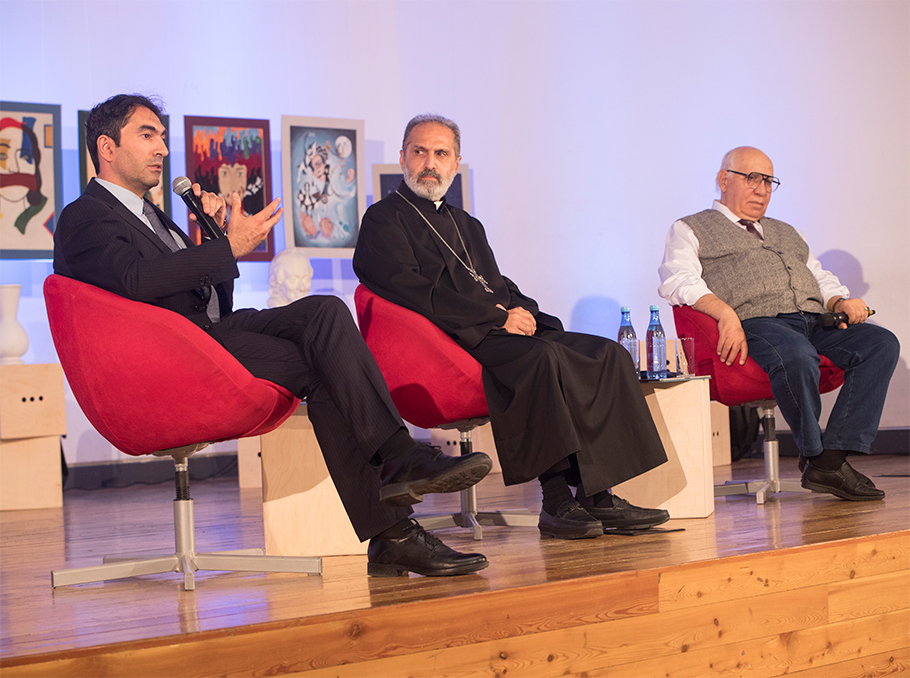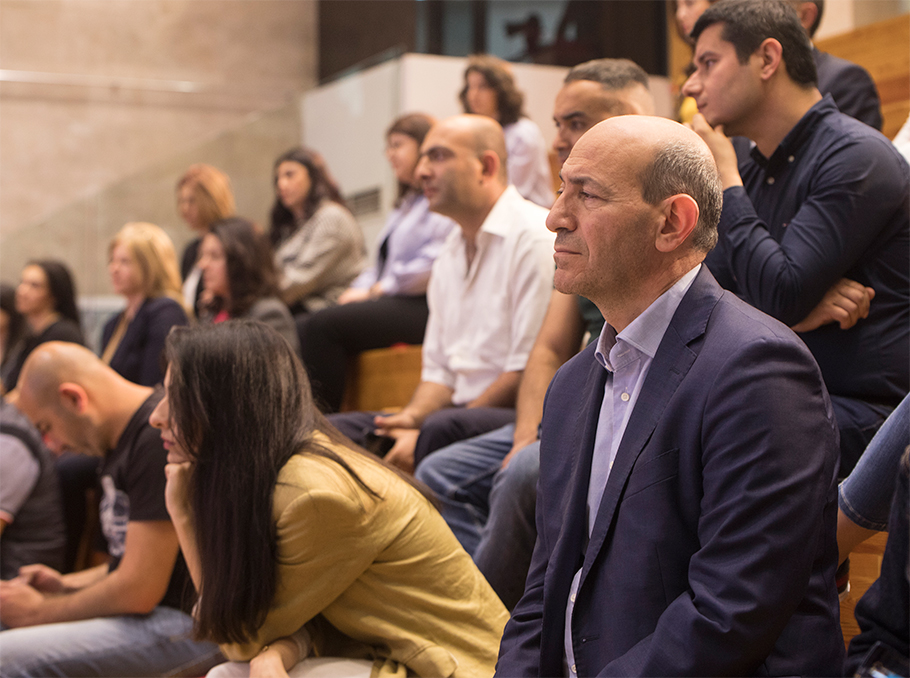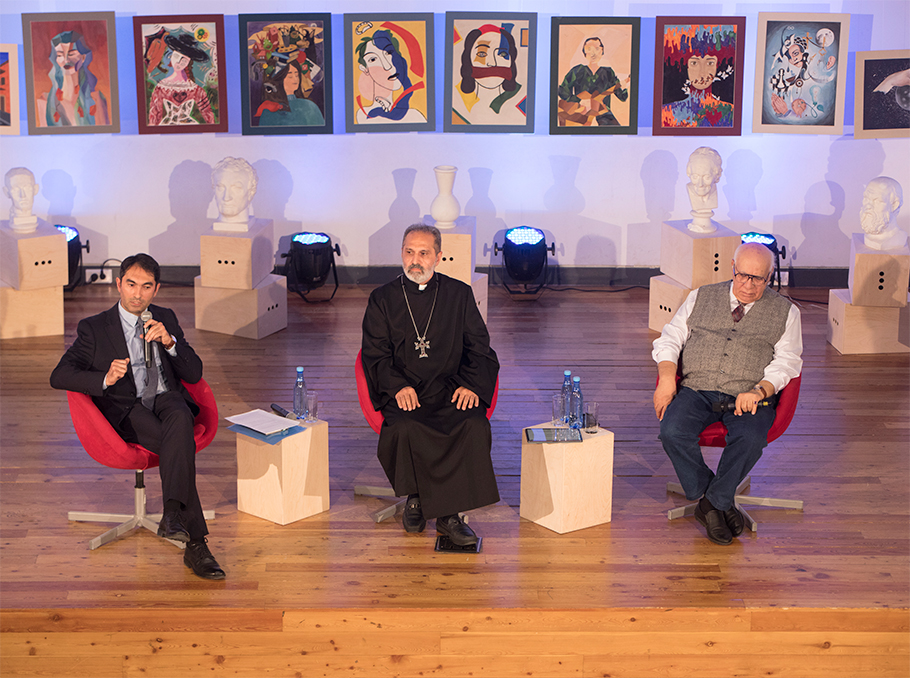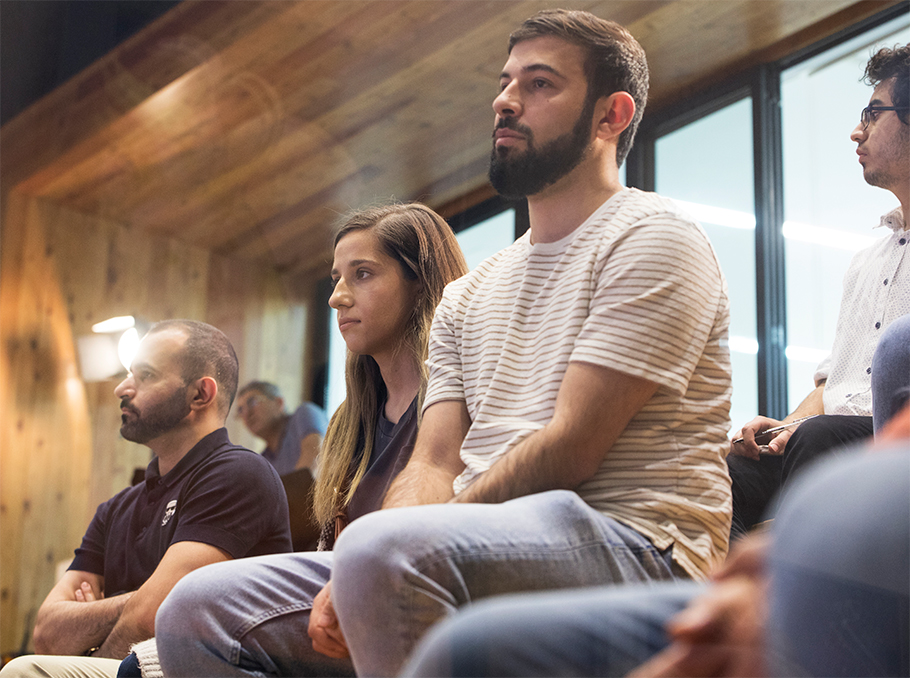The «Keys» to History, the National Elite, and the Answer to «Who Am I?»
People often discuss the lessons not learned from history but rarely focus on how to learn them, how to understand and analyze history, and how to benefit from the past.
During the latest Identity and Values meeting at Ayb School, Professor Albert Stepanyan, head of the World History Department at Yerevan State University’s Faculty of History, Doctor of Historical Sciences, and Professor; Dr. Artur Atanesyan, head of the Applied Sociology Department at Yerevan State University and Doctor of Political Sciences; and Fr. Mesrop Aramian, co-founder of Ayb School, discussed the keys to understanding history.
History: Knowing the Past, Understanding the Present, Shaping the Future
Artur Atanesyan
If we ask why it is important to know what happened in a particular century, the answer might be, perhaps, to learn lessons. However, the fact is that most school and university textbooks do not answer the question: “What should we do?” For instance, when ascending to the Tsitsernakaberd memorial on April 24, we are united, but on our way back from there we are scattered. We go, place flowers, cry, remember—genuinely—but then comes the decline. The steps lead to the dusty, polluted center of Yerevan, and we scatter, speeding up to reach a café and forget.
This is not what history should teach us. If you visit the Jewish cemetery in Budapest on a tour, right before you leave it, the guide will tell you what to do and how to live. Our interpretation and application of history should have such clear directions.
History has three levels: the macro-level (our collective history), the middle level (the history of each of us within our families or groups), and individual history. These three must be interconnected. Our national problem is that we either do not want to or cannot connect our personal histories with our national history.

Albert Stepanyan
History is retrospective, but it is an investigative retrospection for understanding the present and outlining characteristics of the future. Humanity always needs this scientific comprehension: What happened to us? What is happening now? What might happen in the future? These are inherent questions for individuals and societies alike.
Who creates history? There was a perspective from the communist era that the people or the nation create history. Not at all. The people or the nation provide the raw material, but the elite shape it into history and present it to the people, saying, “This is you.” What we lack is the elite—true intellectual, humanitarian elite. If we create an intellectual elite, they will shape our history and our narrative.

We need to create a national elite by uniting all our forces, both from the diaspora and the homeland, so that our raw material becomes history.
Fr. Mesrop Aramian
Interest in the past has always accompanied humanity. If we imagine human life as a tree, the roots are the past, the fruits, or foliage are the future, and the trunk is the present. Without roots, the tree cannot exist, and in this sense, the present and our lives are conditioned by the past. Sometimes the past has a much greater impact on our lives than we realize because much of what we consider our identity has been inherited from the past.

Thus, whether consciously or unconsciously, we invest much of ourselves in the past, considering it a treasury and a source of important lessons. Without the past, we cannot conceive of ourselves as individuals, a society, or a people.
Keys to Understanding History
Albert Stepanyan
There are interesting questions in historiography: Should we first act and then write about it, or can we write first and then act? It turns out that the latter approach is becoming increasingly prominent. In our tradition, starting with Khorenatsi, this approach already exists.

There is a specific craft, a profession. Those who mastered it were once called chroniclers and later historians—people with a particular attitude toward the past, present, and future. Once, this was a function of pagan priests, but historians came and made it scientific. Who is a historian? I can reconstruct history based on my contemporary perceptions. I begin interpreting the past, ascribing my era’s causality, psychology, and behavior to it. Or I can do the opposite—subject myself to their perceptions, understandings, and concepts. In both cases, history remains closed to us. What should we do?

Cicero said we must start a dialogue with history. In writing, history involves at least two people: the person of that time, with their perceptions, approaches, and tastes, and me. There must be a dialogue between us.
For example, let’s say an archaeologist uncovers a grave. Once, someone buried their father there, mourned, and performed rituals. But now, we interpret it completely differently—as a text for understanding the past. How are the bones arranged? What rituals were performed? What worldview did they have? History is dialogical, at the very least, because between the distant individual and me, there may also be other people and authors.
Thus, the historian’s writing depends on how we prepare historians at universities—what music they listen to, what philosophy they read, what films they watch, what taste they have, and what historiographical understanding they possess. Preparing a professional is crucial for organizing this intellectual theater.
Artur Atanesyan
The renowned German scholar Aleida Assmann is well-known for her memory models. She highlights two keys: remembering together and forgetting together.
The first is the “dialogical forgetting” model. If two or more parties, involved in a particular historical event that was traumatic for all, decide to refrain from speaking about it and forget it, they avoid rekindling the conflict. This model is applied by today’s EU countries. They share a traumatic history, particularly World Wars I and II, and actively use this model.

The second key Assmann proposes is the "remember to never forget" model. This is particularly applied by Israel. If you have an exceptional history, even if very traumatic, forgetting it could lead to its continuation or repetition. Thus, not only must you never forget it but you must also actively remind others. This pertains, for example, to Israel’s Holocaust remembrance policy. In the 1960s, Germany proposed dismantling all concentration camps as bad memories, aligning with the first model of forgetting together. But Israel disagreed, asserting that such memories prevent similar atrocities from recurring.

The third tool is called "remember to forget." This model can be exemplified in a person’s life: an individual seeks forgiveness, admits their wrongdoing, and once forgiven, can move on. For instance, Turkey apologizing to Armenia and accepting its guilt aligns with this model. This is what Armenia has demanded for decades. While it may be more difficult in today’s context, it was previously applicable.

There is also the model of “remembering together.” Here, both parties are equally responsible for a particular historical event and decide to remind each other of their actions, feeling equally accountable and ceasing to accuse one another. This model can also be applied positively, for example, by remembering the joint victory in World War II. By reminding each other of that victory, we ensure it is never forgotten and protect each other in the realm of memory. Nations and states always need such allies.
Fr. Mesrop Aramian
In the lives of individuals and nations, repentance is a crucial tool—a key for relating to history. First, you must identify your mistakes; then, you need to recognize your strengths. Abandoning your mistakes and developing your strengths is essential. If we truly want to learn what history has to offer us in a positive sense, we must separate the significant from the insignificant and approach history through a path of purification so that we can discover the virtues and values through which we can realize ourselves and achieve unity in our lives.
Lusine Gharibyan
Photos by Emin Aristakesyan